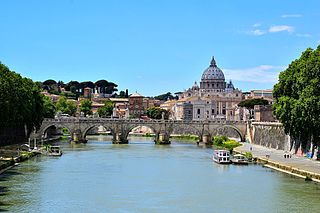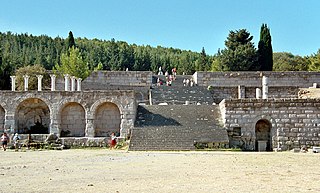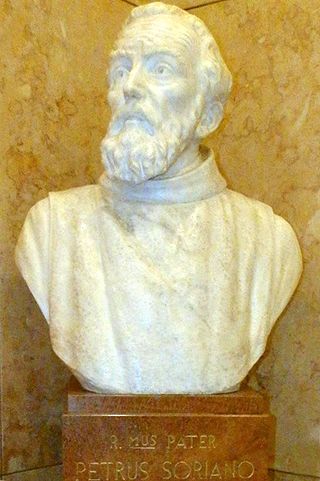
The Tiber is the third-longest river in Italy and the longest in Central Italy, rising in the Apennine Mountains in Emilia-Romagna and flowing 406 km (252 mi) through Tuscany, Umbria, and Lazio, where it is joined by the River Aniene, to the Tyrrhenian Sea, between Ostia and Fiumicino. It drains a basin estimated at 17,375 km2 (6,709 sq mi). The river has achieved lasting fame as the main watercourse of the city of Rome, which was founded on its eastern banks.

Asclepieia were healing temples in ancient Greece, dedicated to Asclepius, the first doctor-demigod in Greek mythology. Asclepius was said to have been such a skilled doctor that he could even raise people from the dead. So stemming from the myth of his great healing powers, pilgrims would flock to temples built in his honor in order to seek spiritual and physical healing.
The Pons Sublicius is the earliest known bridge of ancient Rome, spanning the Tiber River near the Forum Boarium downstream from the Tiber Island, near the foot of the Aventine Hill. According to tradition, its construction was ordered by Ancus Marcius around 642 BC, but this date is approximate because there is no ancient record of its construction. Marcius wished to connect the newly fortified Janiculum Hill on the Etruscan side to the rest of Rome, augmenting the ferry that was there. The bridge was part of public works projects that included building a port at Ostia, at the time the location of worked salt deposits.

Sant'Angelo is the 11th rione of Rome, Italy, located in Municipio I. Often written as rione XI - Sant'Angelo, it has a coat of arms with an angel on a red background, holding a palm branch in its left hand. In another version, the angel holds a sword in its right hand and a scale in its left.

Ripa is the 12th rione of Rome, Italy, identified by the initials R. XII, and it is located in the Municipio I.

The Pons Fabricius or Ponte dei Quattro Capi, is the oldest Roman bridge in Rome, Italy, still existing in its original state. Built in 62 BC, it spans half of the Tiber River, from the Campus Martius on the east side to Tiber Island in the middle. Quattro Capi refers to the two marble pillars of the two-faced Janus herms on the parapet, which were moved here from the nearby Church of St Gregory in the 14th century.

Ponte Sant'Angelo, originally the Aelian Bridge or Pons Aelius, is a Roman bridge in Rome, Italy, completed in 134 AD by Roman Emperor Hadrian, to span the Tiber from the city centre to his newly constructed mausoleum, now the towering Castel Sant'Angelo. The bridge is faced with travertine marble and spans the Tiber with five arches, three of which are Roman; it was approached by means of a ramp from the river. The bridge is now solely pedestrian and provides a scenic view of Castel Sant'Angelo. It links the rioni of Ponte, and Borgo, to which the bridge administratively belongs.

Portus was a large artificial harbour of Ancient Rome. Sited on the north bank of the north mouth of the Tiber, on the Tyrrhenian coast, it was established by Claudius and enlarged by Trajan to supplement the nearby port of Ostia.

Prima Porta is the 58th zona of Rome, identified by the initials Z. LVIII. The name Prima Porta came from an arch of the aqueduct that brought water to the Villa of Livia, which formed over Via Flaminia a sort of gateway which travellers saw as the first indication of having reached Rome (Piperno).

The Basilica of St. Bartholomew on the Island is a titular minor basilica, located in Rome, Italy. It was founded in 998 by Otto III, Holy Roman Emperor and contains the putative relics of St. Bartholomew the Apostle. It is located on Tiber Island, on the site of the former temple of Aesculapius, which had cleansed the island of its former ill-repute among the Romans and established its reputation as a hospital, continued under Christian auspices today.

The Pons Cestius is an ancient Roman bridge connecting the right bank of the Tiber with the west bank of Tiber Island in Rome, Italy. In Late Antiquity, the bridge was replaced and renamed the Pons Gratiani. It is also known as Ponte San Bartolomeo. No more than one third of the present stone bridge is of ancient material, as it was entirely rebuilt and extended in the 19th century after numerous earlier restorations.

Montopoli di Sabina is a town and comune (municipality) in the Province of Rieti in the Italian region of Latium, located about 40 kilometres (25 mi) northeast of Rome and about 20 kilometres (12 mi) southwest of Rieti. In 2011, it had a population of 4,222.

Pedro Soriano, OH (1515-1588) was a Catholic religious brother who succeeded John of God as the First General of Brothers Hospitallers of Saint John of God.

The Temple of Asclepius was an ancient Roman temple to Asclepius, the Greek god of medicine, on the Isola Tiberina in Rome.

The Temple of Isis and Serapis was a double temple in Rome dedicated to the Egyptian deities Isis and Serapis on the Campus Martius, directly to the east of the Saepta Julia. The temple to Isis, the Iseum Campense, stood across a plaza from the Serapeum dedicated to Serapis. The remains of the Temple of Serapis now lie under the church of Santo Stefano del Cacco, and the Temple of Isis lay north of it, just east of Santa Maria sopra Minerva. Both temples were made up of a combination of Egyptian and Hellenistic architectural styles. Much of the artwork decorating the temples used motifs evoking Egypt, and they contained several genuinely Egyptian objects, such as couples of obelisks in red or pink granite from Syene.

Fatebenefratelli Hospital is a hospital located on the western side of the Tiber Island in Rome. It was established in 1585 and is currently run by the Brothers Hospitallers of Saint John of God. The hospital is known for having sheltered Jews during the Holocaust by diagnosing them with a fictitious disease called "Syndrome K".

The following outline is provided as an overview of and topical guide to Rome:

The Temple of Aesculapius located in the gardens of the Villa Borghese, in Rome, was built in the ionic style between 1785 and 1792 by Antonio Asprucci and his son Mario Asprucci, with help from Cristoforo Unterperger. The temple was perhaps built in memory of the destroyed ancient temple to the god of Medicine on the Tiber Island.

In ancient Rome, the Ager Vaticanus was the alluvial plain on the right (west) bank of the Tiber. It was also called Ripa Veientana or Ripa Etrusca, indicating the Etruscan dominion during the archaic period. It was located between the Janiculum, the Vatican Hill, and Monte Mario, down to the Aventine Hill and up to the confluence of the Cremera creek.

The via Tiberina was an ancient Roman road, which from the north of Rome, going up the right bank of the Tiber river, crossed the ancient center of Veio, Capena and Falerii Veteres countryside to Tiber Valley and continued towards Ocriculum, today in Umbria. Today, in the metropolitan city of Rome Capital, its route coincides with the provincial road 15 / A Tiberina.




























